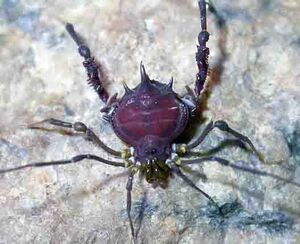| Magnispina | |
|---|---|
 Magnispina neptunus Mendes, 2011 male, Brazil - from Laboratory of arthropod behavior and evolution. Copyright © Glauco Machado | |
|
Suborder |
|
|
Superfamily |
|
|
Family |
|
|
Subfamily |
|
Magnispina Mendes, 2011 is a genus of Heteropachylinae. It was proposed for Magnispina neptunus Mendes, 2011, with two further species added later.[1]
Etymology[]
Genus name comes from the Latin magnus (large) + spina (thorn) in reference to the large median apophysis of free tergite II. Gender feminine. [2]
Distribution[]
Atlantic Forests in States of Espírito Santo and Bahia, Brazil[2] (Fig. 1).

Fig. 1. Distribution of Pseudopucrolia (red, blue, green, orange) and Magnispina (purple). Modified from Mendes (2011)
Species[]
- Magnispina neptunus Mendes, 2011. Type species by monotypy.
- Magnispina bahiana Gueratto, Mendes & Pinto-da-Rocha, 2017.
- Magnispina robusta Gueratto, Mendes& Pinto-da-Rocha, 2017.
Diagnosis[]
This genus can be differed from Pseudopucrolia and Heteropachylus by the combination of the following characters: Three mesotergal areas; mesotergal area III with a pair of tubercles. Median apophysis of free tergite II robust and spiniform, at least twice the tergite length, tergite bearing a stout spiniform apophysis on each corner; free tergite III without a longitudinal keel, with posterior border convex and unarmed corners. Dorsal anal operculum with rounded tubercles. Ventral anal operculum with pair of tubercles irregularly shaped. Calcaneus I same colour as the astragalus and less than half metatarsus I length. Femur IV distinctly curved in dorsal view and with two curvatures (‘S-shaped’) in lateral view, bearing a large dorsobasal apophysis and a row of elongate, rounded tubercles on the prolateral margin, larger in the middle of the row. Male genitalia. Most basal seta of the distal group of setae larger than the others; dorsal digitiform process of glans present[2].
Natural History[]
Magnispina neptunus presents an exclusive paternal care of the offspring. This behavior can also be observed in many species of the clade K92 [3]. Females of Magnispina neptunus use natural cavities in roadside banks as nesting sites, which are defended by males against other males. Then, the females leave the nests after oviposition, and all postzygotic parental care is accomplished by males, which protect the eggs and nymphs from predators [4].
References[]
- ↑ Gueratto, C, Mendes, AC & Pinto-da-Rocha, R. 2017. Description of two new species of Magnispina and a new hypothesis of phylogenetic relationships for Heteropachylinae (Opiliones: Laniatores: Gonyleptidae). Zootaxa 4300: 2, 180-194. DOI: http://dx.doi.org/10.11646/zootaxa.4300.2.2
- ↑ 2.0 2.1 2.2 Mendes, A. C. (2011) Phylogeny and taxonomic revision of Heteropachylinae (Opiliones: Laniatores: Gonyleptidae). Zoological Journal of the Linnean Society 163, 437–483.
- ↑ Caetano, D. S. & G. Machado (2013) The ecological tale of Gonyleptidae (Arachnida, Opiliones) evolution: phylogeny of a Neotropical lineage of armoured harvestmen using ecological, behavioural and chemical characters. Cladistics (2013) : 1–21.
- ↑ Nazareth, T.M., Machado, G., (2010) Mating system and exclusive post-zygotic paternal care in a Neotropical harvestman (Arachnida: Opiliones). Animal Behaviour 79, 547–554

